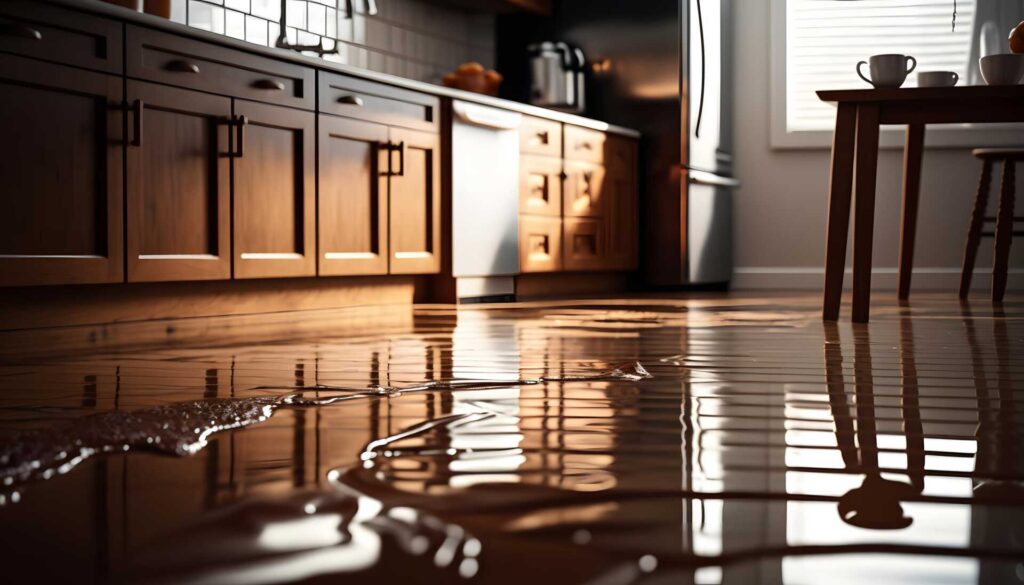
Contents
If you’re a homeowner facing a flood, it’s vital to act quickly and wisely during a flood cleanup. From ensuring your safety to properly documenting the damage, every step matters. Understanding the best practices can make all the difference in your recovery. Let’s explore essential cleanup tips that will help you regain control of your home and minimize long-term effects.
Key Takeaways
- Prioritize safety by checking for structural damage and wearing protective gear before entering your home post-flood.
- Begin water removal immediately using wet vacuums or pumps to minimize further damage.
- Thoroughly assess and document all damage, taking notes and photos for insurance purposes.
- Dry out affected areas completely with dehumidifiers and fans to prevent mold growth.
- Sanitize and restore your home by removing contaminated materials and using effective cleaning supplies.
Ensure Safety First
When you step into your home after a flood, it’s vital to prioritize your safety above all else. Before entering, make sure you’ve followed your evacuation plan and ensure everyone’s accounted for. Check for any structural damage, like sagging ceilings or cracked walls, which could signal danger. If there’s standing water, avoid contact, as it may contain hazardous materials or electrical risks.
Once inside, wear protective gear—gloves, boots, and masks are important to shield you from contaminants. Keep your emergency supplies handy, including a flashlight, first aid kit, and bottled water, as you assess the situation.
If you notice any gas leaks or smell something strange, exit immediately and contact professionals. Remember, your well-being comes first; don’t rush into cleanup tasks before you’re certain it’s secure. Prioritizing safety will help you navigate this intimidating situation effectively.
Begin Water Removal Immediately
After ensuring your safety, it’s time to tackle the water that’s invaded your home.
Begin water removal as soon as possible to minimize damage and prevent mold growth. Use appropriate flood equipment like wet vacuums or submersible pumps for effective water extraction. If you have access to professional-grade tools, they can speed up the process considerably.
Start in the most affected areas and work your way out, prioritizing rooms with standing water. If you’re using a wet vacuum, empty it frequently to maintain suction power.
Remember, the longer water sits, the more damage it can cause.
If the flooding is extensive, consider reaching out to water damage restoration professionals. They’ve the expertise and advanced flood equipment to handle larger volumes of water efficiently.
Your prompt action in removing water can save you time, money, and heartache in the long run.
Assess and Document Damage
Once the water’s been removed, it’s essential to assess and document the damage. Start by walking through each room, taking notes and photos of affected areas.
Be thorough; look for water stains, warped flooring, and damaged walls. This damage assessment will be vital for your insurance claims, so make sure you capture everything, no matter how minor it seems.
Consider creating a detailed inventory of damaged items, including furniture, appliances, and personal belongings. If possible, retain items you can salvage, as they may serve as evidence for your claims.
Don’t forget to note the dates and times of the flooding, as this information can support your case.
Finally, keep all your documentation organized and easily accessible. This will make the process smoother when dealing with your insurance company, ensuring you receive the compensation you deserve for the losses incurred.
Dry Out Affected Areas Thoroughly
As you begin the drying process, it’s crucial to act quickly to prevent further damage and mold growth.
Here are three effective strategies to help you dry out affected areas thoroughly:
Use a Dehumidifier: Set up a dehumidifier in the most impacted rooms. This tool will draw moisture from the air, speeding up the drying process considerably.
Enhance Air Circulation: Open windows and doors to promote airflow. Position fans strategically to push air across damp surfaces, making sure to circulate air in corners and hidden spaces.
Remove Wet Materials: Take out soaked carpets, rugs, and furniture. These items can trap moisture, hindering the drying process and increasing mold risk.
Sanitize and Restore Your Home
While drying out your home is essential, sanitizing and restoring it is equally important to guarantee a safe and healthy environment.
Start by removing any contaminated materials, like carpets and drywall, as they can harbor harmful bacteria. Use cleaning supplies that are effective against mold and mildew, such as a mixture of water and bleach, to wipe down surfaces.
Ensure you focus on areas that often get overlooked, like behind appliances and in corners. After cleaning, consider applying a mold prevention spray to protect your home from future infestations.
Don’t forget about your HVAC system; change the filters and clean the ducts to improve air quality.
Finally, keep an eye on humidity levels with a dehumidifier to maintain a dry environment. By taking these steps, you’ll restore your home and provide a safe space for you and your family.
Final Thoughts
In the aftermath of a flood, every moment counts in restoring your home and peace of mind. By prioritizing safety, acting swiftly, and following the right steps, you can reclaim your space from the chaos. Remember, this isn’t just about cleaning up; it’s about rebuilding your sanctuary. While the road to recovery might feel overwhelming, you’ve got the tools and knowledge to navigate it. Take a deep breath—your home can and will be restored to its former glory.
Recent Posts
Master Flood Recovery: Test Your Water Removal Skills
Many people underestimate the complexity of flood recovery, often thinking it’s just about removing water.
Why Is Emergency Water Removal Crucial After Flooding?
When flooding occurs, emergency water removal is vital to mitigate serious health risks and property
Quick Tips for Post-Flood Water Removal
After a flood, knowing how to act quickly can make a big difference. You need
